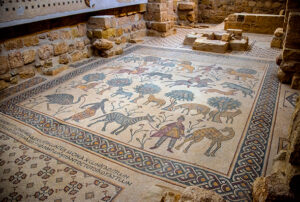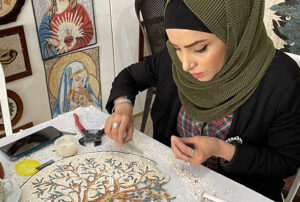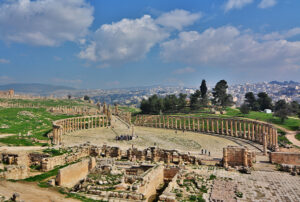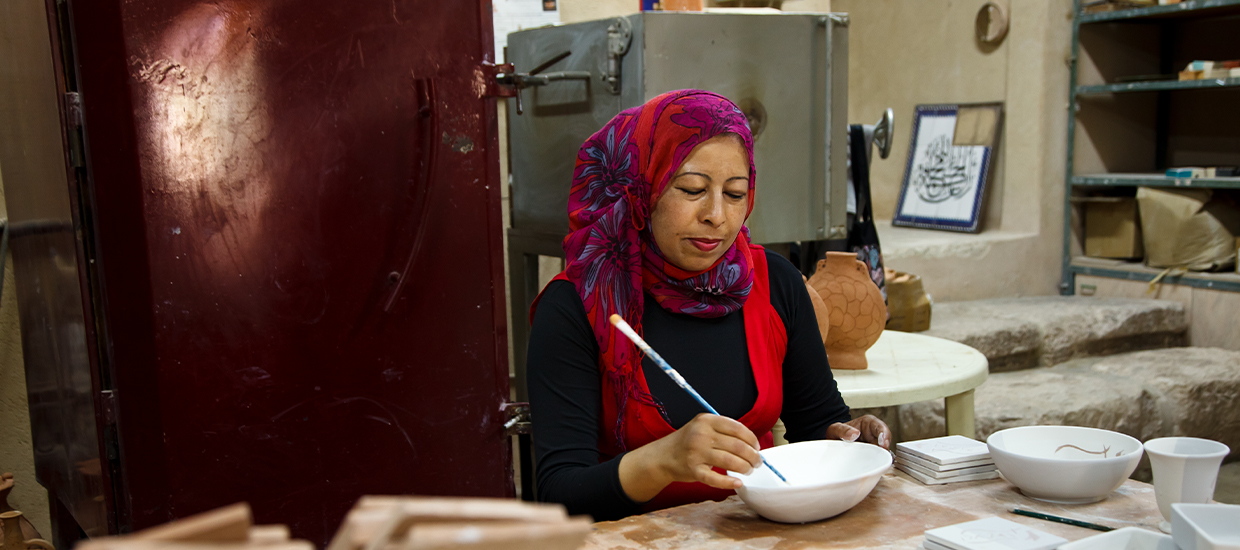My daughter and I almost miss the inconspicuous entrance to Arabella Mosaic Shop in Madaba, Jordan, before the sound of uproarious laughter pulls us back to peek inside. Clustered around a table, three women giggle and chatter as they use tweezers to arrange minute pieces of vividly colored stone into delicate designs.

Named a UNESCO Creative City in 2017, Madaba draws throngs of visitors to see the astonishingly well-preserved Roman, Byzantine, and Umayyad mosaics—many dating back some 2,000 years—that cover the floors of its houses and churches. But here in this tiny room, we realize we’re witnessing the ancient art alive and well in these women’s deft hands.
Arabella is just one example of a nationwide effort not only to preserve and revitalize traditional arts and crafts but also to provide new economic opportunities for women. Wandering the shop, which opened in 2019, we notice that while traditional motifs predominate, the plaques and tables filling every corner of the room also feature brilliant flowers, gamboling animals, even contemporary portraits. “We make the traditional designs for the visitors, but we like to express ourselves with our own ideas also,” says owner Nadira Massarweh. When I ask how the women learned what is clearly a challenging skill, Massarweh says experienced artisans train other women so they can gain employment, confidence, and financial security.

“We work hard, and we also like the chance to be together outside of the house and have independence,” says Arabella artisan Kholoud Shakanbeh, who after an apprenticeship at a different bazaar went on to obtain a diploma from the prestigious Madaba Institute for Mosaic Art and Restoration in 2018. The city’s mosaic artisans include Muslims and Christians, Syrian and Iraqi refugees, and Egyptian expats, Massarweh tells me, adding: “This is art without a passport.”

Visiting two more stores in Madaba—Arts River Mosaic and Nebo’s Pearl—we see that their workforces, again composed largely of women, also include many with Down syndrome and other disabilities. “Jordanian women are empowered, they’re fierce—they just need economic opportunity,” says Jenna Morton, codirector of the Umm al-Jimal Archaeological Project, which spearheads ongoing research and cultural preservation efforts at the archaeological site and surrounding village. “The most exciting sign of success is when the women go on to open businesses and become entrepreneurial, and that’s what’s happening now.”
Four More Craft Markets and Cooperatives to Visit in Jordan
Al-Khader Bazaar
In July 2021, the hillside city of As-Salt was named Jordan’s newest UNESCO World Heritage Site for its Ottoman- era architecture and history of religious tolerance. Just outside the 17th-century Orthodox Church of St. George is Al-Khader Bazaar, which recently launched as part of a youth-led economic revitalization project. The Friday market—with booths displaying beadwork, embroidery, crocheted lace, and spices—is emblematic of the current heritage craft movement.
Umm al-Jimal Women’s Cooperative
Stone carving defines the 2,000- year-old UNESCO-nominated ruins of Umm al-Jimal in Mafraq, where structures and monuments from the Nabatean, Roman, and Byzantine-Umayyad eras were constructed from blocks of the region’s volcanic black basalt. At this cooperative, partially funded by UNESCO and the United Nations Development Programme, villagers learn to make bowls, soap dishes, candleholders, and other objects.
Iraq al-Amir Women’s Cooperative Association
Visitors come to Iraq al-Amir to see the 2nd-century-BCE Qasr al-Abed Palace and the Caves of the Prince, but they stay to visit the Women’s Cooperative Association, housed in Ottoman-era stone cottages. Workshops cover art forms such as weaving, pottery, and making paper from local grasses colored with sumac, coffee, saffron, and paprika. Among the most popular products for purchase are colorful ceramics and bowls molded from hand-pressed paper.
Jordan Craft Center “Al Alaydi”
Founded in 1979, this was one of the first craft-based economic development projects in the country. Now employing more than 100 women in five villages in the Ajloun area, the center has won accolades for reviving ancient embroidery patterns unique to northern Jordan and reintroducing stitches almost lost to time. The dresses, pillows, shawls, and bags are sold at the center in Amman, and some have also been featured in museum exhibits.
Air Jordan: United offers thrice-weekly direct service from Washington Dulles to Amman, Jordan.
